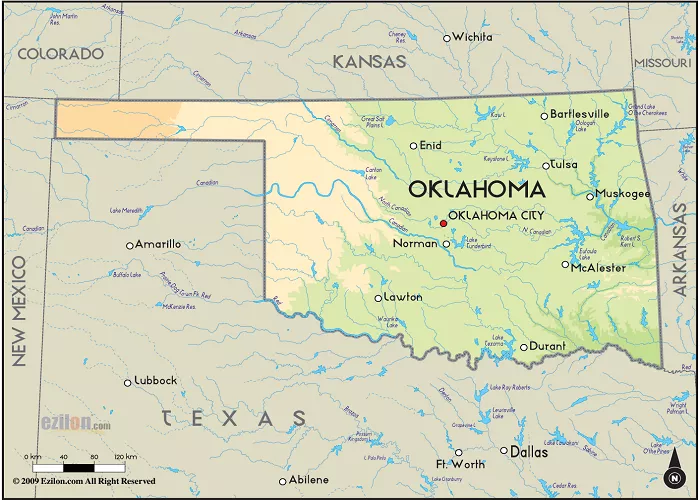Oklahoma is a state located in the south-central region of the United States. It shares borders with six states: Texas to the south and west, New Mexico at the tip of the panhandle, Colorado to the northwest, Kansas to the north, Missouri to the northeast, and Arkansas to the east.
Geography of Oklahoma
Oklahoma is in the southern central part of the United States. It borders six states:
- North: Kansas and Colorado
- East: Missouri and Arkansas
- South: Texas
- West: New Mexico
Its coordinates are approximately 35.5° N latitude and 97.5° W longitude.
Oklahoma’s Position in the U.S. Regions
Oklahoma is part of two major U.S. regions:
- The South Central United States – Often grouped with Texas, Arkansas, and Louisiana.
- The Great Plains – Known for its flatlands and prairies, especially in the western part of the state.
Major Cities and Their Locations
- Oklahoma City (Capital) – Central Oklahoma
- Tulsa – Northeastern Oklahoma
- Norman – South of Oklahoma City
- Lawton – Southwest Oklahoma
Oklahoma’s central location makes it a crossroads for transportation and commerce.
Geography and Landforms
Oklahoma has a varied landscape, including plains, forests, and mountains.
Key Geographical Features
- Great Plains – Covers western Oklahoma with flat, grassy lands.
- Ozark Plateau – Located in the northeast, featuring forests and hills.
- Ouachita Mountains – Southeast Oklahoma, known for rugged terrain.
- Red River – Forms the southern border with Texas.
- Arkansas River – Flows through Tulsa and Oklahoma City.
Climate of Oklahoma
Oklahoma has a humid subtropical climate with hot summers and mild winters. It is also part of Tornado Alley, experiencing frequent severe storms in spring.
Culture
Oklahoma has a deep cultural heritage shaped by Native American tribes and pioneer history.
Native American Influence
Oklahoma is home to 39 federally recognized tribes, including:
- Cherokee
- Choctaw
- Chickasaw
- Creek (Muscogee)
- Seminole
Many tribal headquarters are in Oklahoma, and events like the Red Earth Festival celebrate Native culture.
Western and Cowboy Culture
Oklahoma was a key part of the Old West. Rodeos, cattle drives, and Western movies highlight this heritage. The National Cowboy & Western Heritage Museum in Oklahoma City preserves this history.
Music and Arts
- Country and Red Dirt Music – Popular in Oklahoma.
- Woody Guthrie – Famous folk singer from Okemah, Oklahoma.
- Tulsa’s Arts District – A hub for galleries and performances.
Economy
Oklahoma has a strong economy driven by energy, agriculture, and aerospace.
Major Economic Sectors
Energy Production
-
- Oklahoma is a top producer of oil and natural gas.
- Companies like Devon Energy and Chesapeake Energy are based here.
Agriculture
-
- Major crops: wheat, cotton, and soybeans.
- Oklahoma is a leading state in beef cattle production.
Aerospace & Defense
-
- Tulsa and Oklahoma City have major aerospace facilities.
- Tinker Air Force Base is a key employer.
Transportation and Trade
- Interstate Highways (I-35, I-40, I-44) connect Oklahoma to major U.S. cities.
- Port of Catoosa (near Tulsa) allows shipping access to the Gulf of Mexico.
Conclusion
Oklahoma’s central location in the United States, diverse geography, rich cultural heritage, and robust economy make it a unique and significant state. Whether exploring its natural landscapes, engaging with its cultural institutions, or participating in its economic opportunities, Oklahoma offers a wealth of experiences.

